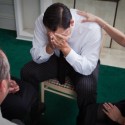Alcohol Dangerous Mix
Increasingly young children and binge drinking are a difficult combination for parents to handle — but we can’t ignore it
The dreaded birds-and-bees talk looks easy compared to this new rite of modern parenthood. Among issues parents are encouraged to talk to their teenage and pre-teen children about is how to identify a case of alcohol poisoning when they see one.
“Don’t leave someone to sleep it off or walk it off and don’t douse him or her with cold water. A person with alcohol poisoning could die in under an hour. So don’t wait it out — get help. It could save a life.” This is some of the advice the Canadian Mental Health Association suggests parents give their teens about drinking. “It will not only encourage them to temper their own drinking, but will help them understand what to do if a friend has had too much alcohol.”
Unlike lifesaving or CPR skills or even ubiquitous fire drills, which they may never have to use, the tips on identifying alcohol poisoning will, sadly, probably come in handy. Perhaps at a weekend house party or neighbourhood park soon.
Binge drinking, once associated with college frat parties, Queen’s homecoming festivities and bush parties, is becoming a routine part of the high school, even junior high school, experience for many teenagers. And no small number end up in the hospital as a result.
“I have four children now aged 18 to 26, and at almost every party they went to in their teenage years, a child was taken to hospital with alcohol poisoning,” former British drug czar David Nutt said recently. If you think he is exaggerating, you are out of touch with teen drinking culture.
Nutt’s comments came after he was removed from his position as head of his country’s Advisory Council on the Misuse of Drugs for expressing the entirely accurate, yet apparently outrageous, opinion that alcohol is more dangerous than cannabis, Ecstasy and LSD. Before being fired, Nutt slammed his country’s drug policies, saying the government should pay more attention to truly dangerous drugs such as heroin and alcohol instead of focusing on those that are less harmful. In 20 years, he predicts, liver disease will outstrip heart disease as the leading killer.
Britain’s drinking culture has been made notorious by drunken soccer hooligans. But Britain is not an island when it comes to kids and binge drinking.
In Germany this week, a seven-year-old boy ended up in intensive care after being found passed out on a sidewalk in a drunken stupor. Officials there say cases of alcohol poisoning among young people are soaring. More than 20,000 minors are admitted to the hospital every year with alcohol poisoning. In California, one boy nearly died after a case of alcohol poisoning at a Halloween party. A teen in the same town died earlier this year after binge drinking.
Binge drinking is a growing problem here as well. An Ontario Student Drug Use and Health Survey done in 2005 found that, among 7,726 students in Grades 7-12, alcohol was the substance of choice. About two-thirds of them said they had drunk alcohol in the past year. About 25 per cent of boys and 20 per cent of girls admitted to binge drinking.
Recently, I sat in a high-school auditorium with a group of parents who heard about the growing prevalence of binge drinking among teenagers, among other things. At Nepean High School, some students have adopted a tradition of staying up all night drinking before the first day of school. This year, the principal began the school year by sending a number of drunk students home to sleep it off.
Parents of high school students agonize over how to prevent their children from drinking or whether it is even possible. Many reluctantly conclude that allowing them to try alcohol at home is the lesser of two evils. At least they know where they are and can monitor the situation.
There is evidence that normalizing drinking cuts down on binge behaviour. U.S. states where the drinking age is 21 have traditionally had bigger issues with binge drinking among college students than in Canada where most university and college students can drink legally.
But high school drinking is another matter. At some schools, particularly more affluent, less diverse schools, a drinking culture can take hold — which makes drinking to excess seem normal to some teenagers, even those who might not otherwise do so.
The consequences can be deadly. Which is why parents are talking about it.
When you can still remember their new-baby smell, it seems wrong to have discussions with your children about behaviour that could kill them or their friends, or to share wisdom like: “A person who has been drinking heavily and is unconscious should be laid on his or her side and watched closely so that he or she doesn’t choke.”
But such are the new ABCs of the teenaged years. Parents and their children should know them well.
source: Ottawa Citizen
